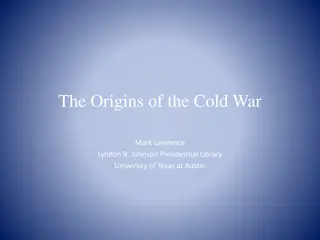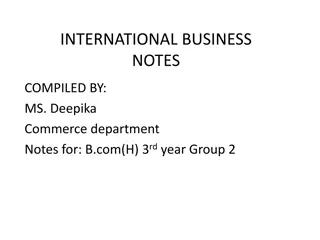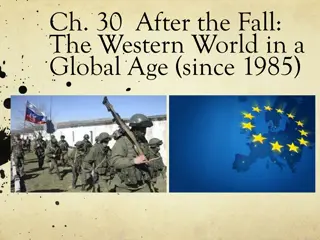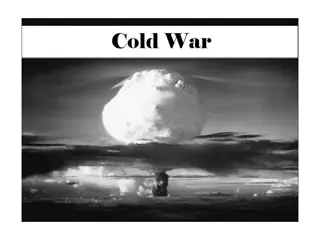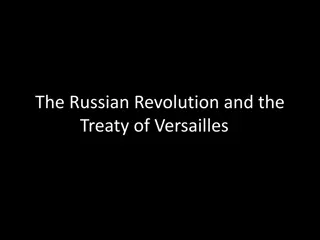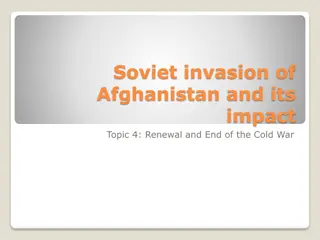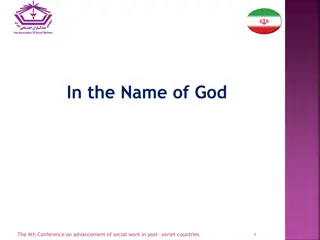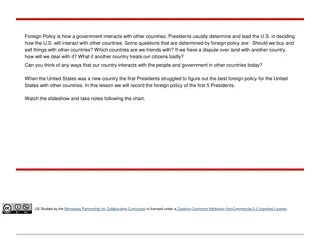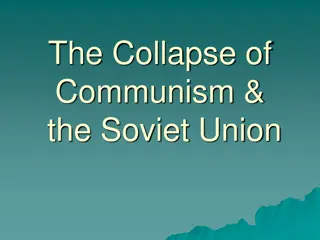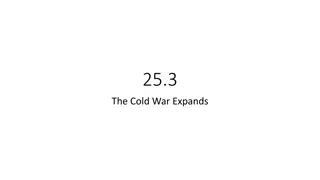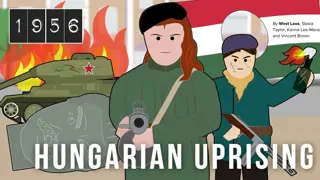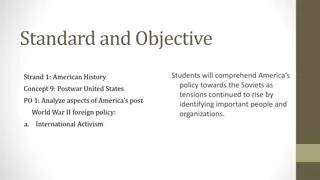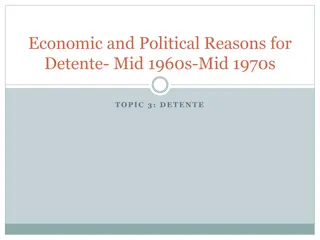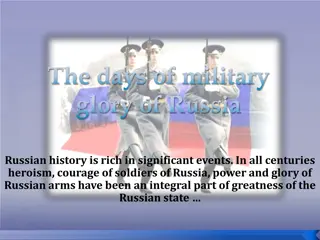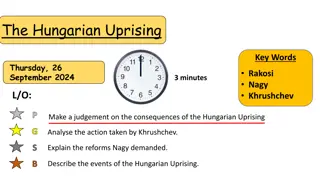Evolution of Russian Foreign Policy Post-Soviet Union
Faced with new challenges and uncertainties after the collapse of the Soviet Union in 1991, Russia had to redefine its foreign policy towards the newly independent states. The search for a new identity and role in the post-Soviet space led to debates and considerable confusion among Russian leaders and the public, shaping the development of Russian foreign policy amidst geopolitical changes and internal struggles.
Uploaded on Apr 04, 2025 | 0 Views
Download Presentation

Please find below an Image/Link to download the presentation.
The content on the website is provided AS IS for your information and personal use only. It may not be sold, licensed, or shared on other websites without obtaining consent from the author.If you encounter any issues during the download, it is possible that the publisher has removed the file from their server.
You are allowed to download the files provided on this website for personal or commercial use, subject to the condition that they are used lawfully. All files are the property of their respective owners.
The content on the website is provided AS IS for your information and personal use only. It may not be sold, licensed, or shared on other websites without obtaining consent from the author.
E N D
Presentation Transcript
FOREIGN POLICY OF RUSSIA FOREIGN POLICY OF RUSSIA Fourth stage Fourth stage Mohammed Ahmed Mohammed Ahmed Mohammed.majeed1@su.edu.krd Mohammed.majeed1@su.edu.krd
The evolution of Russian foreign policy Russia s debates about foreign policy political In 1991, the Soviet Union disbanded into fifteen new states. As the former dominant republic in the Soviet Union, the Russian Federation was the largest and most powerful of these states.
In terms of foreign affairs, Russia was suddenly faced with having to develop, almost from scratch, policies towards the fourteen newly independent states. A whole range of political, economic and military relations had to be forged and old Soviet ties either dismantled or rebuilt. The most serious foreign policy challenge that Russian faced from 1991 to 1996 was how to respond to outbreaks of conflict within its new neighboring states. Soon after the Soviet Union broke up, many hostilities erupted, ranging from minor border battles to outright war.
The search for a new Russian foreign policy in a period of uncertainty Russia s identity after 1991 After the collapse of the Soviet Union there was considerable uncertainty over Russia s identity, its new role in the post-Soviet space and, specifically, the course of action that would best further Russian interests in the nearabroad * states. Russian leaders and the Russian public were faced with an almost paralyzing degree of confusion about which policies would produce greater national security and which would best protect Russian interests. This uncertainty, combined with political and institutional instability, enhanced the importance of ideas and debate in the development of Russian foreign policy.
Develop relations with the world and near abroad The confusion over how to develop Russian foreign policy was not unexpected. Russia, itself a new state, had to develop relations with the rest of the world and with the fourteen other new states which emerged from the Soviet Union. Russia faced a new geopolitical situation. It had inherited 80 percent of the former Soviet territory and 60 percent of the Soviet population. Its economy and resources were comparatively limited, as was its military power. The Russian political elite and public faced great anxieties due to many internal problems. From 1991 to 1996, many dramatic events occurred: the 1993 coup attempt, the first Chechen war, Russia s first experiments with democratization and elections. Moreover, Russia had lost its former position as a superpower on the international stage. The threat of the Cold War was gone, but the perception of insecurity was great.
Lack of clear guidance Within these radically new and uncertain internal and external contexts, and without the previous guidance of a Marxist Leninist philosophy, Russian politicians needed and wanted to find new ways to think about foreign and security policies. There was no obvious or clear direction, especially with regard to the near abroad. The fundamental ideas were so important in helping politicians choose among the various foreign policy options available to the new Russian state. There was little time for the political elite to develop highly nuanced and knowledgeable views, and there were also pressing issues to be tackled in the domestic arena In fact, Russia s political elite advocated various designs which all claimed to advance Russian national interests. Because the participants in the foreign policy debate had divergent preferences over potential ways to act, there was no natural or single policy choice available.
The evolution of Russian foreign policy Before any coherent foreign policy based on national interest could be defined, Russia had to achieve a minimum consensus on its evolving national identity and priorities. The interdependence of foreign and domestic policy in the post-communist era was exceptionally close as Russia sought a favorable international climate to assist economic reform and to facilitate reintegration into the international system. In the first period Russian foreign policy was thoroughly domesticated , with domestic reform taking priority over global ambitions, but gradually the outlines of a more balanced , or as others would put it, a more assertive if not aggressive, policy took shape. Domestic and foreign policy have been thoroughly entwined, although each with its own logic.
The rise of Russia The post-communist era is often compared with the years following Russia s defeat in the Crimean War of 1853 56, when the Chancellor of the Russian Empire, Alexander Gorchakov, stated the famous words: Russia is not angry. Russia is concentrating. Equally, after 1991, Russia was forced to overcome the twin traumas of dissolution and disintegration and under Putin concentrated and then returned to the world stage. Like the two-headed eagle that is Russia s symbol, Russia looks both east and west at the same time, with increasing attention devoted to the north (the Arctic) and the south (notably India, Africa and Latin America) as well.
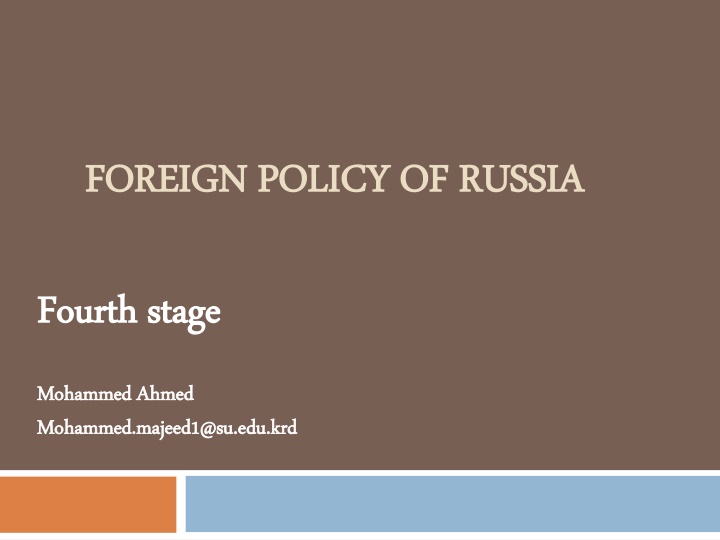

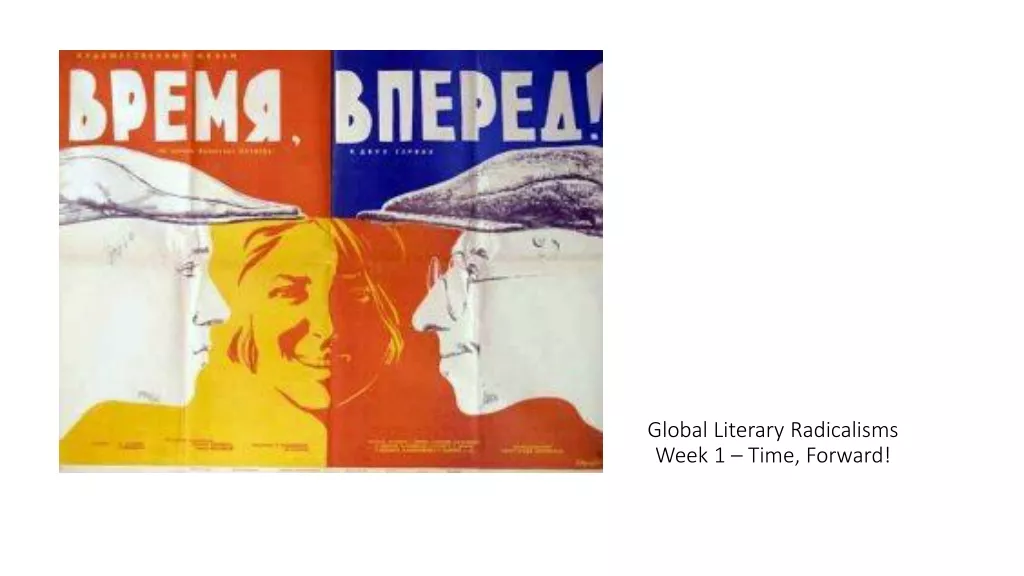
![[PDF⚡READ❤ONLINE] Energiya-Buran: The Soviet Space Shuttle (Springer Praxis Book](/thumb/21613/pdf-read-online-energiya-buran-the-soviet-space-shuttle-springer-praxis-book.jpg)

